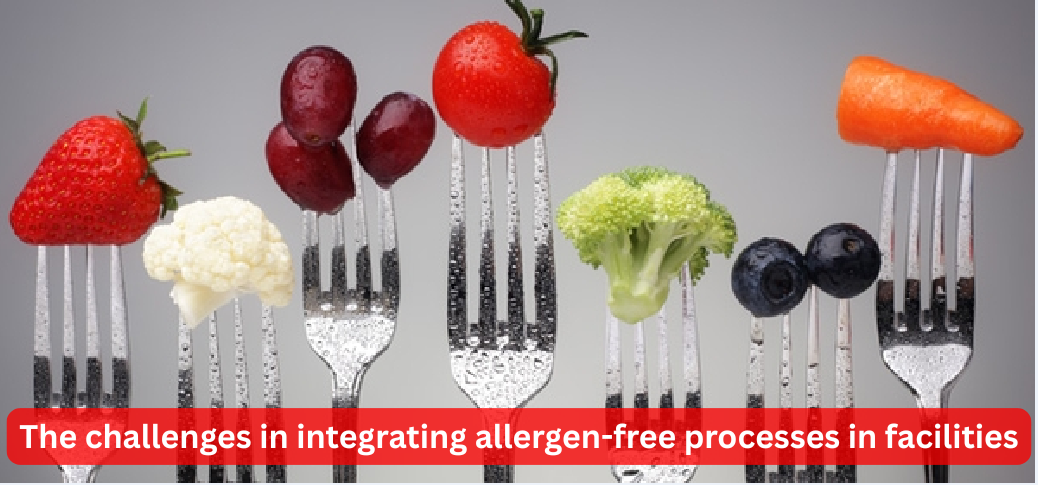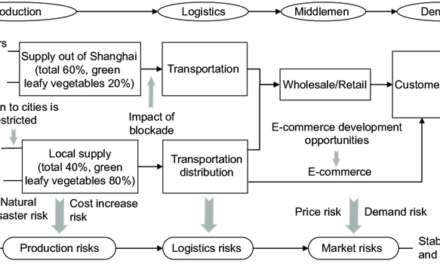Integrating allergen-free processes in food production facilities is critical for ensuring consumer safety and meeting regulatory requirements. However, it presents several challenges due to the complexity of manufacturing environments, supply chains, and operational demands. Here are the key challenges and considerations:
1. Cross-Contamination Risks
- Challenge: Preventing allergen cross-contact during production, storage, and transportation is complex in shared facilities.
- Issues:
- Shared equipment, utensils, or workspaces can inadvertently transfer allergens.
- Airborne particles from ingredients like nuts or flour can contaminate allergen-free zones.
- Solutions:
- Implementing dedicated production lines or allergen-specific scheduling with thorough cleaning protocols between runs.
- Using physical barriers or separate rooms for allergen-containing products.
2. Supply Chain Management
- Challenge: Ensuring raw materials and ingredients are free from cross-contamination throughout the supply chain.
- Issues:
- Suppliers may handle allergens in the same facilities as allergen-free products.
- Inconsistent allergen labeling practices across suppliers.
- Solutions:
- Partnering with certified allergen-free suppliers.
- Conducting supplier audits and requiring allergen declarations.
3. Cleaning and Sanitation
- Challenge: Effective cleaning of equipment and surfaces to remove allergen residues is time-consuming and costly.
- Issues:
- Allergens like gluten or peanut proteins can be difficult to completely remove.
- Validation and verification of cleaning processes require rigorous testing.
- Solutions:
- Use validated cleaning protocols and allergen detection tests (e.g., ELISA kits).
- Train staff in proper cleaning techniques and the importance of allergen control.
4. Employee Training and Awareness
- Challenge: Ensuring all staff understand the critical nature of allergen management and adhere to protocols.
- Issues:
- Lack of awareness about the severity of allergic reactions.
- Human errors, such as using the wrong utensils or failing to follow cleaning procedures.
- Solutions:
- Regular training programs emphasizing allergen risks and management practices.
- Clear signage and visual reminders in allergen-sensitive areas.
5. Labeling Accuracy
- Challenge: Ensuring accurate and clear allergen labeling on all products.
- Issues:
- Mislabeling due to errors in ingredient documentation or processing.
- Regulatory variations in allergen labeling requirements across countries.
- Solutions:
- Establish robust labeling review processes.
- Use allergen management software to track ingredients and automate labeling.
6. Facility Design Constraints
- Challenge: Modifying existing facilities to accommodate allergen-free processes can be expensive and logistically challenging.
- Issues:
- Limited space for separate production lines or storage areas.
- High cost of installing separate ventilation systems for airborne allergens.
- Solutions:
- Optimize workflow to minimize cross-contact risks in shared facilities.
- Gradual investment in infrastructure improvements.
7. Regulatory Compliance
- Challenge: Meeting strict allergen management regulations while maintaining operational efficiency.
- Issues:
- Variability in allergen regulations by region (e.g., the “Big 8” allergens in the U.S. vs. the “Big 14” in the EU).
- Documentation and audit requirements add administrative burdens.
- Solutions:
- Stay updated on regulatory changes and ensure compliance through routine audits.
- Maintain thorough records of all allergen control measures.
8. Product Development Limitations
- Challenge: Creating allergen-free products without compromising taste, texture, or nutritional value.
- Issues:
- Difficulty finding high-quality allergen-free substitutes for key ingredients like dairy, eggs, or nuts.
- Risk of cross-contact during formulation trials.
- Solutions:
- Partner with suppliers specializing in allergen-free ingredients.
- Use innovative food technologies to develop alternative ingredients.
9. Increased Costs
- Challenge: Allergen-free processes often require additional resources, increasing production costs.
- Issues:
- Higher costs for specialized ingredients, cleaning, testing, and equipment.
- Loss of efficiency due to downtime for thorough cleaning.
- Solutions:
- Optimize production scheduling to minimize cleaning downtime.
- Balance costs by targeting premium markets willing to pay for allergen-free products.
10. Consumer Trust and Communication
- Challenge: Building and maintaining consumer trust through transparent allergen management practices.
- Issues:
- Fear of recalls or negative publicity from allergen-related incidents.
- Consumers with severe allergies demand detailed information on manufacturing processes.
- Solutions:
- Clearly communicate allergen-free claims and controls on packaging and marketing materials.
- Engage with consumers through education on allergen safety practices.
11. Testing and Validation
- Challenge: Ensuring allergen-free claims are verified with reliable testing methods.
- Issues:
- Inconsistencies in sensitivity and specificity of allergen testing kits.
- Costs and delays associated with routine testing.
- Solutions:
- Use validated testing methods (e.g., ELISA, PCR) and conduct regular audits.
- Monitor ingredient batches for hidden allergens.
12. Managing Recalls
- Challenge: Recalls due to allergen contamination can damage brand reputation and lead to financial losses.
- Issues:
- Identifying and isolating affected batches quickly.
- Maintaining consumer trust after an incident.
- Solutions:
- Develop a robust recall plan with traceability systems.
- Maintain open communication with regulatory bodies and consumers during recalls.
Conclusion
Integrating allergen-free processes in food production facilities requires a multi-faceted approach involving stringent controls, employee training, reliable suppliers, and advanced testing. While challenges exist, proactive planning and investment in infrastructure, technology, and education can help companies meet consumer demand for allergen-free products while ensuring safety and compliance.
Hashtags
#CulturalCulinary #FoodieAdventures #InternationalEats #CulturalDishes #FoodExploration #CulinaryTraditions #TasteOfCulture #GlobalTastes #CulturalCuisine #FoodieFinds #DiverseDining #InnovativeFlavors #CulturalFusionFood #FoodCultureExperience #BeverageAdventures #TasteBudsTravel #CulturalGastronomy #FoodieJourney #DiversePalates #CulinaryHeritage









